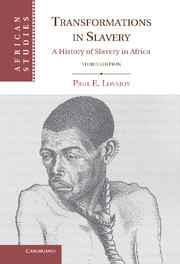Book contents
- Frontmatter
- Contents
- Maps and Tables
- Note on Currencies, Weights, and Measures
- Preface
- Preface to the Second Edition
- Preface to the Third Edition
- 1 Africa and Slavery
- 2 On the Frontiers of Islam, 1400–1600
- 3 The Export Trade in Slaves, 1600–1800
- 4 The Enslavement of Africans, 1600–1800
- 5 The Organization of Slave Marketing, 1600–1800
- 6 Relationships of Dependency, 1600–1800
- 7 The Nineteenth-Century Slave Trade
- 8 Slavery and “Legitimate Trade” on the West African Coast
- 9 Slavery in the Savanna during the Era of the Jihads
- 10 Slavery in Central, Southern, and Eastern Africa in the Nineteenth Century
- 11 The Abolitionist Impulse
- 12 Slavery in the Political Economy of Africa
- Epilogue
- Appendix Chronology of Measures against Slavery
- Notes
- Select Bibliography
- Index
- Books in this series
11 - The Abolitionist Impulse
Published online by Cambridge University Press: 05 June 2012
- Frontmatter
- Contents
- Maps and Tables
- Note on Currencies, Weights, and Measures
- Preface
- Preface to the Second Edition
- Preface to the Third Edition
- 1 Africa and Slavery
- 2 On the Frontiers of Islam, 1400–1600
- 3 The Export Trade in Slaves, 1600–1800
- 4 The Enslavement of Africans, 1600–1800
- 5 The Organization of Slave Marketing, 1600–1800
- 6 Relationships of Dependency, 1600–1800
- 7 The Nineteenth-Century Slave Trade
- 8 Slavery and “Legitimate Trade” on the West African Coast
- 9 Slavery in the Savanna during the Era of the Jihads
- 10 Slavery in Central, Southern, and Eastern Africa in the Nineteenth Century
- 11 The Abolitionist Impulse
- 12 Slavery in the Political Economy of Africa
- Epilogue
- Appendix Chronology of Measures against Slavery
- Notes
- Select Bibliography
- Index
- Books in this series
Summary
The Reluctant Move Toward Abolition
By the last decades of the nineteenth century, the African social order was more firmly rooted in slavery than ever before. This meant that Africa and Europe were on a collision course in which slavery was a major issue, even if Europeans did not always recognize it as such. The imperialist momentum thrust a new social and political system on Africa, in which there was no room for slavery. Even though the pressure for change came from without, African societies were far from passive participants. The internal dynamics of the political economy were closely associated with the transformation of slavery into a productive system, sometimes connected with the external market and sometimes part of regional developments. The transformation was far from uniform. In large parts of Bantu Africa, slavery was linked to the regeneration of social and political institutions, as before. But along the East African coast, in the northern savanna, and on parts of the West African coast, slavery had become essential to the organization of production, no matter what social and political roles were also satisfied through slave use.
The greater use of slaves, involving a transformation in the means of production, demonstrates an adjustment to the world economy of the nineteenth century. Unfortunately, alternatives to slavery were not seriously considered until late in the century, and then primarily as a result of European pressures on the African political economy. The long history of slavery had established the flexibility of the institution in controlling people, organizing production, arranging marriages, and bypassing custom. As long as slaves were readily available, they could be used in every conceivable capacity. Only when the source of slaves and the means of distributing them within Africa were undermined did slavery cease to be a viable institution. From the middle of the nineteenth century, the European colonial role was to whittle away at the means of enslavement and distribution. Despite a mythology of abolition, this role was not readily accepted. If there was a passive agent in the history of slavery during the nineteenth century, it was Europe, not Africa. Africa struggled to reform slavery in a changing context. The various European colonial powers did their best to avoid or circumscribe the commitment to abolition, reluctantly pursuing the fight whenever compromise proved impossible. Abolition was eventually achieved not so much because of the desire to end slavery but because the modern industrial system and a slave-based social formation were incompatible. In Marxist terms, the clash was based on the contradictions between different modes of production. The demise of slavery was inevitable in the context of absorption into a capitalist world economy.
- Type
- Chapter
- Information
- Transformations in SlaveryA History of Slavery in Africa, pp. 244 - 266Publisher: Cambridge University PressPrint publication year: 2011

